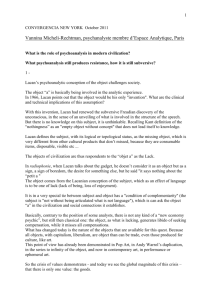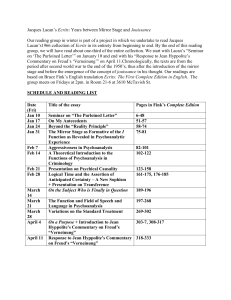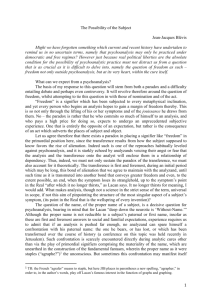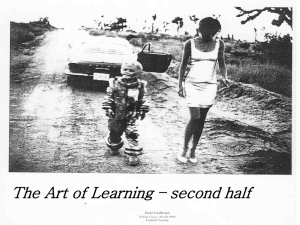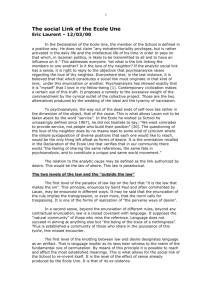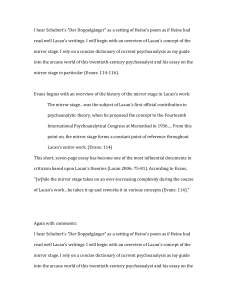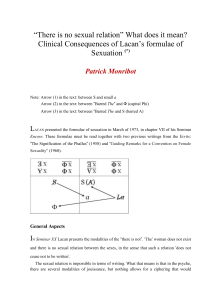Anguishing dream: between the `scene` and the real - Apres
advertisement
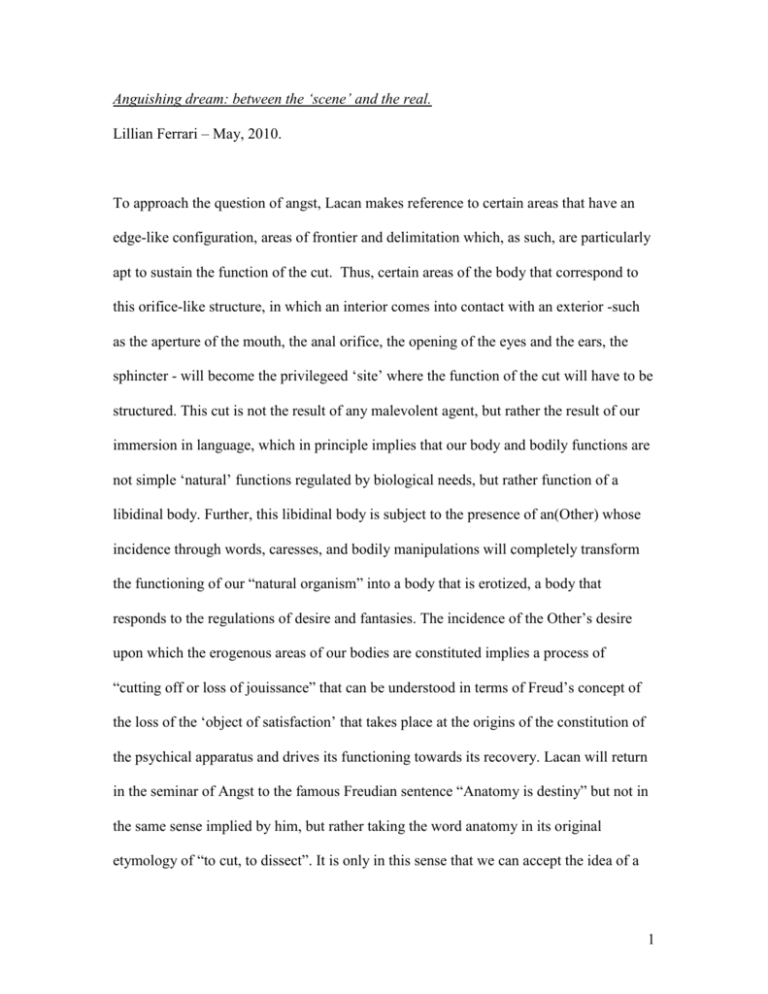
Anguishing dream: between the ‘scene’ and the real. Lillian Ferrari – May, 2010. To approach the question of angst, Lacan makes reference to certain areas that have an edge-like configuration, areas of frontier and delimitation which, as such, are particularly apt to sustain the function of the cut. Thus, certain areas of the body that correspond to this orifice-like structure, in which an interior comes into contact with an exterior -such as the aperture of the mouth, the anal orifice, the opening of the eyes and the ears, the sphincter - will become the privilegeed ‘site’ where the function of the cut will have to be structured. This cut is not the result of any malevolent agent, but rather the result of our immersion in language, which in principle implies that our body and bodily functions are not simple ‘natural’ functions regulated by biological needs, but rather function of a libidinal body. Further, this libidinal body is subject to the presence of an(Other) whose incidence through words, caresses, and bodily manipulations will completely transform the functioning of our “natural organism” into a body that is erotized, a body that responds to the regulations of desire and fantasies. The incidence of the Other’s desire upon which the erogenous areas of our bodies are constituted implies a process of “cutting off or loss of jouissance” that can be understood in terms of Freud’s concept of the loss of the ‘object of satisfaction’ that takes place at the origins of the constitution of the psychical apparatus and drives its functioning towards its recovery. Lacan will return in the seminar of Angst to the famous Freudian sentence “Anatomy is destiny” but not in the same sense implied by him, but rather taking the word anatomy in its original etymology of “to cut, to dissect”. It is only in this sense that we can accept the idea of a 1 certain destiny for the parlettre, insofar as our body to be constituted as such must pass through the signifier, through the Other. That passage is what constitutes the real “Ananke through which the jouissance must be confronted with the signifier” (Sem X, pag. 193) Indeed, angts will make itself present precisely in the place that has been destined for the cut, as a failure of it, and that is the reason why certain phenomenological effects of angst must be conceived as blurring of the distinctions, confusing that which should have been otherwise differentiated: for example, the blurring of he distinction between the ego and the non-ego in the phenomenon of the double; the blurring of the registers of fiction and reality that occurs in the genre of fantastic literature; the blurring of the difference between desire and jouissance and that may occur at certain moments in the subjective experience of desire; and lastly, the distinction between the “scene and the world’ that Lacan mentions at the beginning of the seminar, where he considers the scene as the domain of the signifying representation and the world as the real that has to make itself represented in the scene, in accordance with the laws of the signifier’ (pag. 43) The term scene, has Freudian resonances, including the notion of the other stage where dreams take place, that needs to be distinguished not so much from the awakening life (Lacan will say that we wake up to continue dreaming) but rather from the real. So then, where does one localize the function of angst? Lacan emphasizes that the constitution of the subject presupposes its passage through the field of the Other, which means that the desire of the Other will impact the child under the shape of a signifier that results in a cut, a cut that, at the level of narcissism we can conceive as a separation, as a cut between the real of the organism and the libidinal body, the narcissistic body. 2 Thus, Lacan will go back to the optical schema that had already been used to formulate the constitution of narcissism, but this time he will draw attention to the distinction between the specular –objects that have an image- and those which are non- specularized, those objects which neither have an image nor a representation in geometrical space. The use of this schema will permit Lacan to localize the precise place of the appearance of angst, situating its privileged locus of emergence at the juncture of the imaginary and the real. This precise localization explains why its emergence tend to shake the imaginary beliefs and certainties that are proper to the ego, which can be taken as the habitual points of references through which the ego organizes itself within its own surroundings. When it appears, angst may be experienced as a feeling of a real disorientation in space, and even a sense of ego disintegration, a sense of losing one’s own boundaries. The scheme also permits Lacan to say that angst is “framed”; there is a structure for angst. For this reason, the two forms that are closest to it in the sense of veiling it will be the fantasm and the image of the body. The notations for both express this proximity: for the image of the body, we have the notation i’(a) and for the formula of the fantasm $^a. These two forms, the body and the fantasm, are the site of very strong libidinal investments. They have the function of ‘dressing up’ the object a, constituting on the one hand, a screen for the real of the body, and on the other, a veil for the real of desire. If these two forms confine with the real, it is because ultimately they constitute a subjective response to the hole opened up by the question of the che vuoi?, to the irreducible enigma created by the desire of the Other. In the optical schema, the notation minus phi on the side of the virtual mirror coincides with the edge of the mirror and the border of the vase, there where the possibility of 3 reflection encounters its own limit. It is there that Lacan writes minus phi, as a notation for the lack, but making it clear, at the same time, that there is no image of the lack. This place of border or delimitation will become the preferential point for the appearance of angst, and that is why the presence of angst will provoke a blurring, an erasure of distinctions, as it is wonderfully revealed in the literature concerning the subject of the double. In an excellent essay, Otto Rank investigates the analytical and psychological roots of the subject of the double in the literature and in the movies. He finds that the creation of the figure of the double is based on an unconscious wish on the part of the protagonist to repudiate castration and death. Indeed, he argues that the creation of the double is an attempt on the part of the subject to create his alter ego as a way of fending himself off from any sort of narcissistic constrain, thereby saving himself from any ills and damages that inevitably affect the body through aging and death. However, that which the character wants to deny will come back to haunt him, since in almost all the tales pertaining to this type of literature, the protagonist of the story finds his own death in the hands of his double, revealing once again the mortifying aspect of narcissism when it is not limited by castration. Angst is not without an object, Lacan teaches us. And the existence of this object, which he calls object a is related to the fact that the subject, in order to constitute itself, has to be represented in the field of the Other, a field that is at the same time Other and heim, its dwelling, its home. This Other place where the subject finds its representation induces a lack, an absence of a part of him/herself that, while being a condition for representation, making representation possible, is itself excluded from the field of representation, subsisting as an irrepresentable reminder. Without a representation and without an image, 4 this reminder is the most intimate yet most unrecognizable, strangest part of one’s own. Lacan approaches this remainder as a piece of the body because it responds to our bodily existence, our reality of having a body that can be experienced, enjoyed and suffered beyond those imaginary or ideal representations of it. Object a is the necessary condition that has to be lacking in order that a representation of the subject in the field of the Other may occur, there where the lack is ‘preserved’. It is precisely in those cases where the lack is lacking that we witness the emergence of angst. Concerning angst dreams, especially those dreams where the function of sleeping is interrupted, the affect of angst disturbs the very conditions of the ‘staging’ that the scene displays in the dream, disrupting suddenly. Thus, the places of predilection for the manifestation of angst would be those places where there is an aperture, a small opening, or a crack, as for example the open window crack in the case of the dream of the Wolf man, a dream that wonderfully illustrates the relations of the fantasm with the real. Says Lacan “In this place, circumscribed by something that is materialized in the image as a border, as an edge, an aperture, a gap, there were the constitution of the image shows its limits –that is the preferential place of angst. This borderline phenomenon, your will find it for instance, in certain privilege occasions, in that window that is opened suddenly, marking the limit of the illusion that pertains to the world of recognition, that I call the “scene or the stage”. That edge, that boundary place is illustrated here at least two times –in the edge of the mirror, and also with this small sign (the losange of the fantasm) (121) The famous dream of the wolves of the Wolf man case shows with singular vividness the significance and the subjective impact that marks the constitution of the primordial scene, 5 a scene of which, Freud was convinced the wolfman had been a witness. Freud thus speculated that the fixed gazed sustained by the immobilized wolves in the tree were, in fact, the wolfman’s own gazed fixed at the moment of the parental coitus, the coitus a tergo. But we may ask why is this oneiric representation so traumatic and full of consequences for the wolf man? And further, what is fundamentally being evoked there in the dream through this fixed gazed emanating from the wolves, which leaves him so petrified and anguished that the only response he can elicit is the constitution of a phobia? I believe that what is fundamentally evoked in this scene is the real incidence of the Other’s desire, under the form of the gaze of the Other, that structurally antecedes the constitution of the subject. Normally, during the mirror stage, the incidence of the presence of the desire of the other will be translated into the shaping of an image that will precipitate the identification of the child, an identification that ultimately responds to that desire. The identification to an ideal image through which I see myself as being loveable and desirable, presupposes the existence of the Other’s desire, which at the level of the mirror stage, we can characterize primarily as the gaze of the Other. However, the presence of this real gaze needs to be veiled, hidden, absented from the field of representation; otherwise its appearance will cause angst. In that sense, the function of the plane mirror, as a metaphor for the presence of the symbolic Other and as the place of the Ego Ideal that precipitates the identification of the subject as the vantage point from which he captures himself as lovable, is precisely to mask, to cover up that gaze. If this is so, is because before this gaze, the subject, far from being in a position of mastery and control, is rather in a position of object, an object for the jouissance for the Other. 6 The moment of awakening coincides with the appearance of object a in the frame, in the threshold of the dream, marking that fugitive moment in which the distortion of the elements in the dream are not enough to protect the dreamer from this gaze that threatens to engulfed him. BIBLIOGRAFIA Lacan, Jaques. El Seminario 10 La Angustia. Buenos Aires: Ed Paidos. 2006. Rank, Otto: El Doble. Buenos Aires: Ed. Nueva Vision. 2004. 7
